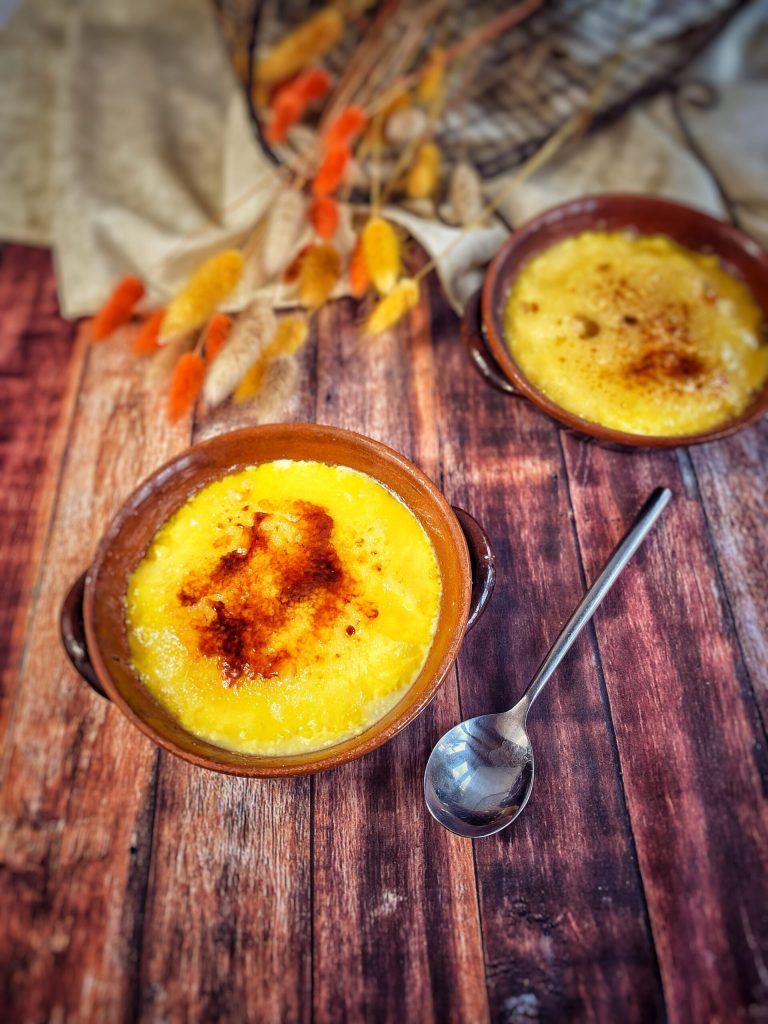The Crème brûlée or crème brulée, also known as burnt cream or Trinity cream, is a custard made from a base of cooked English cream topped with a crunchy sheet of caramelized sugar.
▶The English cream used is completely based on liquid cream instead of milk and, unlike pastry cream, contains no starch.
🌟This differentiates it from the Catalan cream which, on the contrary, is made with custard.
▶Also called Trinity cream because in England this dessert has a strong and traditional association with Trinity College, Cambridge, where since 1879 it has been customary to prepare it by imprinting the school’s emblem on its top.
▶▶In English, it is also called burnt cream, meaning “burnt cream”.
▶The first documented recipe dates to a French cookbook from 1691. Despite the name, it seems to have English origins, being an old name for the recipe, “English cream” (crème anglaise).
🌟The other difference with Catalan cream is the type of cooking, in a water bath, instead of on the stove.
▶▶I used the sous vide cooking technique, which means vacuum, cooking the cream for 1 hour at a water temperature of 176°F.

- Difficulty: Easy
- Cost: Economical
- Preparation time: 10 Minutes
- Portions: 4 servings
- Cooking methods: Oven, Other
- Cuisine: French
- Seasonality: All seasons
Ingredients for Crème brûlée sous vide:
- 5 oz sugar
- 1 pod vanilla
- 6 egg yolks
- 1 2/3 cups heavy cream
Tools
- 2 Vacuum bags
- 1 Blowtorch
- 4 Ramekins terracotta
Steps for the Crème brûlée sous vide:
Beat 2.5 oz of sugar with the vanilla and egg yolks. Add the cold cream.
Divide the mixture into two vacuum bags and seal them.
Cook for 1 hour in water at a constant temperature of 176°F.
Dip in ice water to cool, then divide into ramekins, sprinkle with the remaining sugar, and burn with the blowtorch.

Sous vide cooking:
Sous vide cooking:
For sous vide cooking – vacuum – I used Vakuum Sealer by Inkbird to seal the cream in the bags.
You can cook the bags simply in a pot with water maintaining a constant temperature of 176°F (with the help of a thermometer) or use a Rooner sous vide.
You can cook the bags simply in a pot with water maintaining a constant temperature of 176°F (with the help of a thermometer) or use a Rooner sous vide.
Amelie’s Wonderful World
If I had to associate this dessert with a movie, as I did with the Menu 10 recipes for 10 films, I would have no doubt: “Amelie’s Wonderful World”…
“Amélie Poulain enjoys simple pleasures. Skipping stones along the Saint-Martin Canal, running her hand through a sack of legumes, and above all, breaking the crust of crème brûlée with a spoon…”
“Amélie Poulain enjoys simple pleasures. Skipping stones along the Saint-Martin Canal, running her hand through a sack of legumes, and above all, breaking the crust of crème brûlée with a spoon…”
Discover my review on the professional food vacuum sealer INKBIRD INK-VS02
FAQ
What is sous vide cooking?
With the French expression sous vide, we refer to the method of vacuum cooking, at low temperatures, which allows cooking food sealed inside special bags.
The cooking of food in the absence of oxygen occurs gently and evenly, at not too high temperatures, ranging between 122°F and 212°F.
Based on temperature and cooking times, different types of vacuum cooking are distinguished:
Low temperature cooking with prolonged times (LTLT: Low Temperature, Long Time)
With short times (HTST: High Temperature, Short Time)
Higher with prolonged times (HTLT: High Temperature, Long Time)
Low temperature cooking with short times (LTST: Low Temperature, Short Time)

